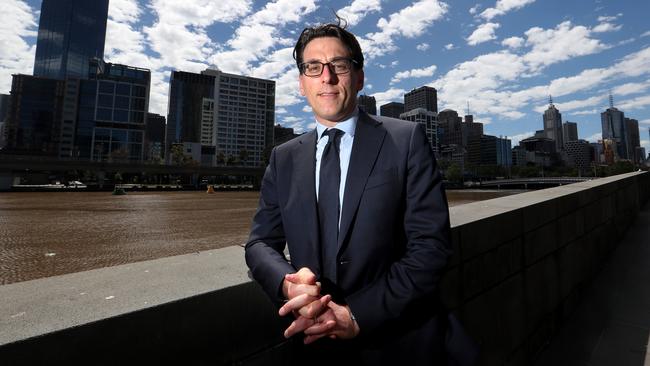Ignore the ‘hype’ and keep an eye on valuations: Dion Hershan warns on complacency
Dion Hershan isn’t buying all the ‘hype’ of a bull market driven by a narrow group of factors.

Dion Hershan isn’t buying all the “hype” of a bull market driven by a narrow group of factors.
The executive chair and head of Australian equities at Yarra Capital Management warns against complacency after a 70 per cent rise in Australian shares in the past 18 months as iron ore prices dive from record highs and banks are priced for perfection in terms of their bad debt provisions.
Driven by unprecedented fiscal and monetary policy stimulus globally in response to the coronavirus pandemic, the sharemarket has set records, including a 24 per cent rise in the S&P/ASX 200 index last financial year and consecutive gains for the past 11 months.
It has pulled many along for the ride, but valuations shouldn’t be ignored.
Yarra Capital Management is one of Australia’s largest independently owned fund management groups, with about $22bn of funds under management.
Since inception in 1996, the Yarra Australian Equities Fund has returned 9.84 per cent per annum after fees, outperforming the ASX 200 Accumulation Index by 28 basis points.
The fund returned 32 per cent after fees for the year to July 31, outperforming by 350 basis points.
With rates set to remain near zero at least until 2024 according to the Reserve Bank, yield-starved investors will have little choice but to reinvest about $40bn of dividends being paid in September and October – as well as the proceeds of share buybacks and takeovers – back into the sharemarket.
With the economy and the consumer in good shape, it’s hard to make the case for a collapse or even a major correction in the market, normally defined as a fall of 10-20 per cent.
However, there are some headwinds for shares including cost inflation, rising bond yields as central banks start to taper pandemic-era quantitative easing programs, stretched valuations in the industrials sector and fading levels of government support.
In that environment, Hershan says investors should be patient and selective.
An “extraordinary” 28 per cent growth rate for aggregate earnings in the 2021 financial year – the best in a decade – was mainly driven by a 76 per cent rise in mining earnings.
Most of that came as iron ore prices more than doubled to a record $US233 a tonne on supply disruptions and China’s surging steel output, as well as a 29 per cent rise in bank sector earnings as bad debt provisions were written back to zero as policy stimulus fuelled another housing boom.
But the iron ore price has halved in the past four months.
China’s August industrial production data this week showed crude steel output dived for a third month in a row, with output down 13.2 per cent on-year to just over 82 million tonnes – the biggest fall since March last year – as China pressed ahead with its plan to cap steel output as its 2021 level.
That pushed Singapore iron ore prices down 12 per cent in two days to $US106 a tonne.
Hershan says there were clear signs of overheating in China in the first half of the year.
Beijing’s directives to cut steel production, curtail property price growth, tighten credit, curtail commodity speculation and cut emissions are an “ominous lead indicator” for commodity prices, which are largely being ignored by the market.
He disagrees with the consensus view that the August reporting season was “strong”.
While the recovery in earnings and dividends and the raft of buybacks was welcome, they have to be viewed in the context of narrow underlying drivers, which are “unlikely to be sustained”.
Other sectors combined saw 14 per cent growth in earnings, assisted by record government support, low interest rates, a weaker exchange rate and temporary expense cuts. But even with this support, earnings for these sectors overall are still 24 per cent below pre-Covid levels.
While reporting season largely met expectations, the market is bullish on the year ahead, even as iron ore prices fall and banks’ bad debt provisions could rise as lockdowns disrupt growth.
On top of the 28 per cent earnings growth last year, the consensus forecasts another 15 per cent growth from a 49 per cent rise in energy earnings and a 14 per cent rise in financials earnings.
The optimism is tempered by expectations of just 3 per cent earnings growth from industrials ex-financials, which nevertheless trade at a record high 31.1 times forward earnings, or 85 per cent above their long-term average.
Bulls should note that federal stimulus will fall from $250bn in FY21 to $41bn in FY22. There is also input cost inflation, with Brent crude up 30 per cent on its FY21 average, freight costs surging, and wage inflation hitting double-digits for specialists in some sectors. Companies are having to reinstate expenses that may have been avoided in FY21 – including travel, bonuses, advertising and marketing – even though some of this will drive sales.
Hershan says if the iron ore price averages $US100 a tonne and the banks experience bad debts in line with the long-term average of 20 basis points of loans, aggregate earnings growth for the ASX 200 would be just 3 per cent, rather than 15 per cent.
Buying iron ore miners just for their now chunky dividends is a mistake, in his view. If iron ore goes back to long-term forecasts of $US65 over time, dividends could fall by a third.
Against this backdrop, his fund is “treading carefully, holding quality companies that will come through the crisis stronger given real pricing power and market leadership such as Carsales.com and James Hardie”.
It has also been reducing positions in groups including Healius and BlueScope, where earnings are “unsustainably high”.







To join the conversation, please log in. Don't have an account? Register
Join the conversation, you are commenting as Logout